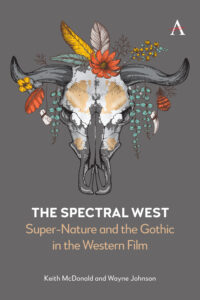This is an author interview by Keith McDonald and Wayne Johnson, authors of The Spectral West: Super-Nature and the Gothic and the Western Film
Q1. What was the importance of writing this book now?
The Western has always been cyclical in terms of its popularity and the ways that it responds to socio/political/cultural tensions. For example, the esteemed film critic Robin Wood recognised that nihilistic Westerns such as Clint Eastwood’s High Plains Drifter (1973) were part of a wider ‘apocalyptic’ turn in Vietnam era culture, while others have noted the ultra-violence embedded in post-9/11 Westerns (what we frame as a part of New Viscera in the genre). Following on from this, we recognise that a particular strand of Westerns embedded Gothic elements which went beyond the simple visual codes attributed to the genre. We also recognised that the recent upsurge in the Western is clearly and complexly responding to the dramatic political landscape of contemporary America. This can be seen in, for instance, the emergence of Taylor Sheridan (Hell or High Water [2016]) as a writer who is chronicling furious divisions that dominate American cultural discourse. Other films, such as Quentin Tarantino’s Django Unchained (2012), provide a cinematic voice in the discussion in the Black Lives Matter movement. The Western continues to act as a mirror that reflects America’s aspirations and disasters, where we detect the spectral influence of the Gothic and many of these reflections and refractions. We believe that the book is relevant in terms of the issues raised above, but also think it is important to look back and chart this reflective and refractive quality across the history of Western on-screen.
Q2. What are the key ideas of the book that you wanted to get across?
We wanted to emphasise the uncanny relationship that has long existed between the Gothic and the Western form. This can be seen in seminal Westerns such as The Searchers (1956) as well as in overlooked masterpieces, for example, The Gunfighter (1950). Equally germane to this, however, is the crucial spectral importance of landscape, as depicted in the Gothic storm sequence in She Wore a Yellow Ribbon (1949). Many more recent films, such as The Wind (2018), Meek’s Cutoff (2011) and The Power of the Dog (2021), reveal a strong supernatural presence. In all of these cases, they contain the repressed trauma at the heart of European Victorianism, out on the Western plains. We purposely avoided including those ‘weird Westerns’ (such as Dracula vs Billy the Kid [1966]) as we are more enthused by those that adhered to the nuanced union of the uncanny and the Western tradition.
Q3. Who will derive the most benefit from reading this book?
Scholars and students who are interested in film history will find an interpretation of many Western films that have drawn upon the Gothic aesthetic (what we call the ‘refracted Gothic’) and, in doing so, may reconsider some canonical films and filmmakers, and also find reading of certain films which have not found themselves in the limelight. The genre fiction is essentially a large part of popular culture, and our work naturally draws together a range of pop cultural artifacts that reach a wide audience. This includes not only popular and celebrated cinematic Westerns (such as The Revenant [2015] or Sicario [2015]) but also the revival of the Western on television, with series such as The English (2022), with the excellent Emily Blunt, and the outstanding AMC series Dark Winds (2022–). So, we hope that this book finds an audience outside of the academy, as it is built upon the potency and popularity of genre screen fiction in the cultural ecology.
Q4. What enduring ideas has writing the book left you with?
There is a curious feature of the Western that typifies genre fiction. It is, at a glance, rather repetitive in terms of the narrative conventions and motifs that make it one of the most iconic cinematic modes. Yet it is remarkably malleable, and these well-established genre tropes act as a kind of shorthand that allows artists to engage in complex dialogue with their audiences by using a familiar cinematic language. The Gothic has the same quality, which is perhaps why it is such a resilient popular art form. In analysing the long running symbiosis between these two genres, we realised that such similarities (the prominence of landscape, the tension between the individual and the community, etc.) may at first appear as a curious phenomenon; however, our research revealed that symbiosis is part of a shared deep cinematic grammar rather than some sort of stylistic mash-up, which the esteemed scholar Neil Campbell describes as ‘deeply troubling’.
Q5. Is there any film that you think typifies the blend of the Gothic and the Western on screen?
One film that does this to startling effect is William A. Wellman’s 1943 The Ox-Bow Incident, starring Henry Fonda. The film is essentially a morality crisis centring around a sinister ad hoc lynching trial that tests the moral fibre of a community (not dissimilar to some of the thematic propellant of another Fonda classic, 12 Angry Men [1957]). The film is not only visually stunning in expressing this moral trauma using the Gothic palette but also incredibly nuanced in the ways in which it asks its audience to engage with the ethical crisis it presents. It is a Gothic Western not only in terms of its exquisite visual composition but also in its bombastic and unnerving critique of moral corruption.
